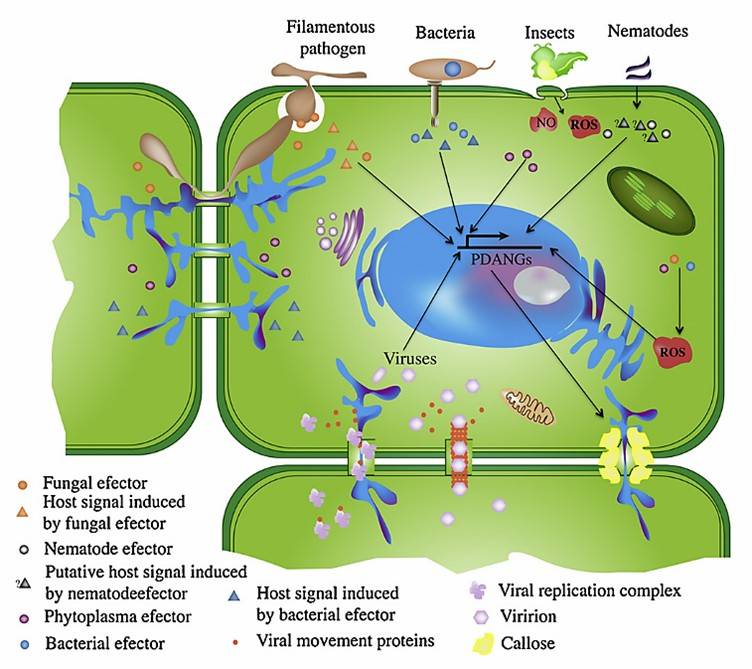Lifeasible helps to study key factors in plant-pathogen interactions and offers services to study the role of plasmodesmata in plant-pathogen interactions.
Plasmodesmata (PD) are membranous intercellular nanochannels crossing the plant cell wall. PD connect adjacent cells of plants and not only maintains communication between plant cells but also control metabolite partitioning. PD also play an important role in plant-pathogen interactions (Fig. 1). Plants can regulate the opening and closing of PD for innate defense. Pathogens also promote infection by regulating PD. For example, plant viruses encode movement proteins (MPs) that can target PD and increase the PD size exclusion limit (SEL) to allow viruses to spread between host cells via PD. Lifeasible offers specialist research services to help study the status of PD in plant-pathogen interactions and the influencing factors.
 Fig. 1 PD are involved in pathogenicity and defense (Ganusova and Burch-Smith, 2019).
Fig. 1 PD are involved in pathogenicity and defense (Ganusova and Burch-Smith, 2019).
Detecting the status of PD
The density, morphology, and permeability of PD can all affect plant-pathogen interactions, and we offer services to help detect these.
We mainly help detect PD density in plant leaves. We generally use the Plant-Enzyme-Assisted (PEA)-CLARITY method for tissue clearing, which is more convenient as it does not require sectioning. We then use three-dimensional (3D) immunolocalization fluorescence microscopy and scanning electron microscopy (SEM) for stable and accurate quantification of PD density. PD are approximately 30-50 nm in diameter, and we use array tomography to help image the ultrastructure of PD at high throughput for detecting PD morphology. We mainly rely on Green Fluorescent Protein (GFP) and the Drop-ANd-See (DANS) dye for permeability measurements. We recommend DANS-based measurement, which is non-invasive, real-time, and in situ.
Detecting the accumulation of callose
Callose (a β-1,3-glucan polysaccharide) can control intercellular transport by regulating the accumulation at PD. It is an important influence on PD status. We help to detect the accumulation of callose at PD. We quantify callose levels by quantitative confocal microscopy and pigment aniline blue staining, which can be used as an indirect evaluate the SEL of PD.
Detecting PD-located plasmodesmal permeability regulators
We offer services to help discover the molecules that regulate PD permeability. We help isolate PD membranes for lipidomic and proteomic analysis to discover potential regulators. We first isolate the pure cell wall containing the intact PD and then enzymatic degrading cell wall matrix to release the PD membrane for analysis. Using the protein-protein interactions approach, we also help study regulatory proteins that interact with PD-localized proteins (PDLP).
Constructing mutants to determine the effect of mutant genes on PD
We help construct pathogen or plant mutants that overexpress or suppress gene expression under test by various methods and help examine the effect of this mutant on plant PD density, morphology, and permeability to determine the relationship between the gene and PD. We also help to examine the effect of this mutant on PD-associated callose or PD-localized proteins to determine a more detailed mechanism of effect.
Lifeasible offers specialist services to help study the status of PD and the associated effects in plant-pathogen interactions. We have expert measurement methods and advanced instrumentation to help achieve efficient detection. Please contact us to help you with your research.
References
Lifeasible has established a one-stop service platform for plants. In addition to obtaining customized solutions for plant genetic engineering, customers can also conduct follow-up analysis and research on plants through our analysis platform. The analytical services we provide include but are not limited to the following:
STU-CRISPR System Improves Plant Genome Editing Efficiency
April 19, 2024
Application of Exosomes in Facial Beauty
April 12, 2024